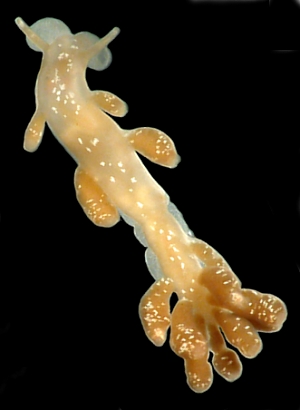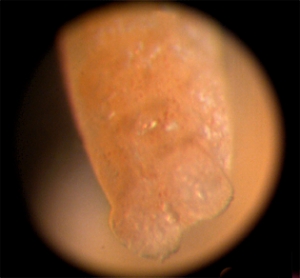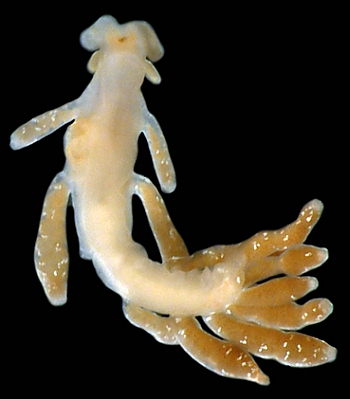Embletonia pulchra - first record in the Subarctic
May 24, 2007
From: Alexander Martynov


Dear Bill,
I have sent you some information for a Fact Sheet onEmbletonia pulchra to accompany this record from the subarctic.
This is the first record for northern seas of Russia and for the Subarctic. From Northern Norway this species was never reported (Evertsen, Bakken, 2005). A single specimen (7.5 mm length, mature) was found in August of 2005 in middle intertidal of Yarnyshnaya Inlet, Barents Sea on coarse shelly gravel. There is only one record of the late 19th century (Perejaslavtseva, 1891) from Russia, from Sevastopol area, Black Sea, which then was cited in some monographs [e.g. Milashevitch, 1916; Golikov, Starobogatov, 1972] without findings of any additional specimens.
Locality: A single specimen (7.5 mm length, mature) was found in August of 2005 in middle intertidal of Yarnyshnaya Inlet, Barents Sea on coarse shelly gravel. Photos: Tatiana Korshunova
This species is adapted for dwelling within coarse sand and gravel. The body is very narrow and elongated, but considerably shorter than in the tropical member of the genus, E. gracilis. There are no oral tentacles, instead there are a pair of flattened anterior lobes. The rhinophores are quite short and thin. Up to 10 elongated but somewhat swollen cerata originate from each side of the body. General body colour is yellowish white, with opaque white speckles medially and on the papillae. Colour of the digestive gland diverticulum in the papillae are reported to be from pale yellow to red. The Barents Sea illustrated specimen had yellowish-light brown digestive gland. Although E. pulchra is usually considered to have rounded tips to the cerata, more detailed study shows slightly bilobed tips (photo) probably previously described as pads containing nematocysts (e.g. Marcus & Marcus, 1958).
- Cervera J.L., Calado G., Gavaia C., Malaquias M. A. E, J. Templado, J. Ballesteros M.,. García-Gómez J. C, Megina C. 2004. An annotated and updated checklist of the opisthobranchs (Mollusca: Gastropoda) from Spain and Portugal (including islands and archipelagos). Boletín Instituto Español de Oceanografía 20 (1-4): 3-122.
- Evertsen, J. & Bakken, T. 2005. Nudibranch diversity (Gastropoda, Heterobranchia) along the coast of Norway. Fauna Norvegica, 25: 1-37.
- Golikov A.N., Starobogatov Ya.I. 1972. Mollusca, Gastropoda. In: Guide to the Fauna of the Black and Azov Seas. Vol. 3. Kiev, Naukova Dumka, 340 pp.
- Jensen K.R., Knudsen J. 1995. Annotated checklist of recent marine mollusks of Danish waters. Jørgen Knudsen, Copenhagen, 73 pp.
- Labbé, A. 1923. Note préliminaire sur cinq espèces nouvelles d'Eolidiens de la Station de Croisic. Bulletin de la Société Zoologique de France 48: 265-268.
- Løyning, P. 1927. Nudibranchs from Bergen, collected in the neighborhood of the Biological Station at Herdla. Nyt Magazin for Naturvidenskaberne 65: 243-264.
- Maitland R.T. 1897. Prodrome de la faune des Pays-Bas et de la Belgique Flamande ou enumeration systématique de tous les animaux y observés depuis 1679-1897 excepté les araignées et les insectes, 62 pp. E. J. Brill, Leiden.
- Marcus, Ev., Marcus Er. 1958. Opisthobranchia aus dem Schill von Helgoland. Kieler Meeresforschungen 14(1): 91-96.
- Martynov A.V., Korshunova T.A., Savinkin O.V. 2006. Shallow-water opisthobranch molluscs of the Murman coast of the Barents Sea, with new distributional data and remarks on biology. Ruthenica, 16(1-2): 59-72.
- Milashevitch K.O. 1916. Molluscs of the Russian Seas. Vol. 1. Molluscs of the Black and Azov Seas. Fauna Rossii i Sopredelnykh Stran (Faune de la Russie et des pays limitrophes). St.-Petersburg, 312 pp.
- Nobre, A. 1931. Moluscos marinhos de Portugal. Instituto de Zoologia da Universidade do Porto, 466 pp.
- Odhner N.H. 1907. Northern and Arctic invertebrates in the collection of the Swedish State Museum (Riksmuseum). III. Opisthobranchia and Pteropoda. Kungl. Svenska Vetenskaps Akademiens Handlingar, Neue Følge 41(4): 1-113.
- Odhner N.H. 1939. Opisthobranchiate Mollusca from the western and northern coast of Norway. Det Kongelige Norske Videnskabers Selskabs Skrifter (Meddelels fra Trondheims Biologiske Stasjon, 115), 1: 3-93.
- Perejaslavtseva S.M. 1891. Additions to the fauna of the Black Sea. Trudy Obshchestva Ispytatelei Prirody pri Imperatorskom Khar'khovskom Universitete, 25: 235-274.
- Schmekel R.L., Portmann A.. 1982. Opisthobranchia des Mittelmeeres, Nudibranchia und Saccoglossa. Fauna e flora del Golfo di Napoli 40, Monografia della Stazione Zoologica di Napoli, 410 pp.
- Thompson T. E., Brown G.H., 1984. Biology of opisthobranch molluscs, vol. 2, 229 pp., Ray Society, no. 156.
Kind regards,
Alexander
Alexander Martynov
Zoological Museum of Moscow State University
Moscow
sasha_martynov@inbox.ru
Martynov, A., 2007 (May 24) Embletonia pulchra - first record in the Subarctic. [Message in] Sea Slug Forum. Australian Museum, Sydney. Available from http://www.seaslugforum.net/find/19935
Dear Alex,
Thanks for this interesting addition to the Forum. I am always grateful when contributors provide Fact Sheet material - it saves me much time
Best wishes,
Bill Rudman
